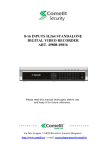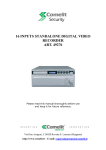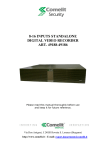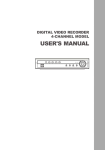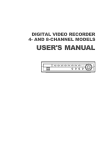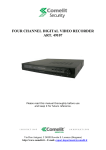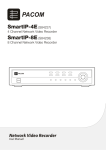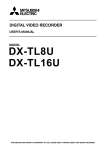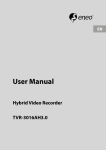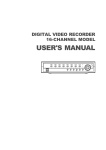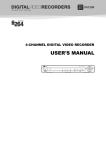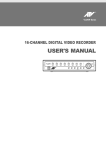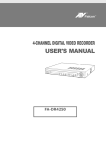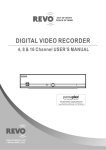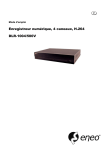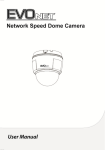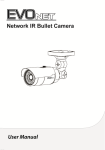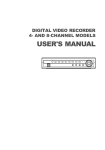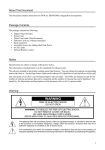Download Untitled - Comelit
Transcript
Digital Video Recorder art. 49804 WARNINGS AND CAUTIONS WARNING TO REDUCE THE RISK OF FIRE OR ELECTRIC SHOCK, DO NOT EXPOSE THIS PRODUCT TO RAIN OR MOISTURE. DO NOT INSERT ANY METALLIC OBJECT THROUGH THE VENTILATION GRILLS OR OTHER OPENINGS ON THE EQUIPMENT. CAUTION Explanation of graphical symbols The lightning flash with arrowhead symbol, within an equilateral triangle, is intended to alert the user to the presence of uninsulated "dangerous voltage" within the product’s enclosure that may be of sufficient magnitude to constitute a risk of electric shock. The exclamation point within an equilateral triangle is intended to alert the user to the presence of important operating and maintenance (servicing) instructions in the literature accompanying the appliance. The user is obliged to inform himself and to conform himself to the national and local rules concerning the monitoring and the audio and video recording. Nobody else will consequently be held responsible for an improper use of this system which could break the laws in force. i User’s Manual FCC COMPLIANCE STATEMENT FCC INFORMATIONS: THIS EQUIPMENT HAS BEEN TESTED AND FOUND TO COMPLY WITH THE LIMITS FOR CLASS A DIGITAL DEVICE, PURSUANT TO PART 15 OF THE FCC RULES. THESE LIMITS ARE DESIGNED TO PROVIDE REASONABLE PROTECTION AGAINST HARMFUL INTERFERENCE IN A RESIDENTIAL INSTALLATION. THIS EQUIPMENT GENERATES, USE AND CAN RADIATE RADIO FREQUENCY ENERGY AND, IF NOT ISTALLED AND USED IN ACCORDANCE WITH THE INSTRUCTIONS, MAY CAUSE HARMFUL INTERFERENCE TO RADIO COMMUNICATIONS. HOWEVER, THERE IS NO GUARANTEE THAT INTERFERENCE WILL NOT OCCUR IN A PARTICULAR INSTALLATION. IF THIS EQUIPMENT DOES CAUSE HARMFUL INTERFERENCE TO RADIO OR TELEVISION RECEPTION, THE USER IS ENCOURAGED TO CORRECT THE INTERFERENCE TO OWN EXPENSES. CAUTION: CHANGES OR MODIFICATIONS NOT EXPRESSLY APPROVED BY THE PARTY RESPONSIBLE FOR COMPLIANCE COULD VOID THE USER’S AUTHORITY TO OPERATE THE EQUIPMENT. THIS CLASS A DIGITAL DEVICE COMPLIES WITH CANADIAN RULES. CE COMPLIANCE STATEMENT WARNING: THIS IS A CLASS A DIGITAL DEVICE. IN A DOMESTIC ENVIRONMENT THIS PRODUCT MAY CAUSE RADIO INTERFERENCE, IN WHICH CASE THE USER MAY BE REQUIRED TO TAKE ADEQUATE MEASURES. The software included in this product contains some Open Sources. You may obtain the complete corresponding source code from us. See the Open Source Guide on the software CD (OpenSourceGuide\OpenSourceGuide.pdf) or as a printed document included along with the User's Manual. ii Digital Video Recorder art. 49804 IMPORTANT SAFEGUARDS 1. Read Instructions All the safety and operating instructions should be read before the appliance is operated. 10. Overloading Do not overload wall outlets and extension cords as this can result in the risk of fire or electric shock. 2. Retain Instructions The safety and operating instructions should be retained for future reference. 11. Objects and Liquids Never push objects of any kind through openings of this equipment as they may touch dangerous voltage points or short out parts that could result in a fire or electric shock. Never spill liquid of any kind on the equipment. 3. Cleaning Unplug this equipment from the wall outlet before cleaning it. Do not use liquid aerosol cleaners. Use a damp soft cloth for cleaning. 4. Attachments Never add any attachments and/or equipment without the approval of the manufacturer as such additions may result in the risk of fire, electric shock or other personal injury. 5. Water and/or Moisture Do not use this equipment near water or in contact with water. 6. Pacing and Accessories Do not place this equipment on an unstable cart, stand or table. The equipment may fall, causing serious injury to a child or adult, and serious damage to the equipment. This equipment and cart combination should be moved with care. Quick stops, excessive force, and uneven surfaces may cause the equipment and cart combination to overturn. Do not place this equipment on a closed space. Sufficient amount of ventilation air is necessary to avoid increase of ambient temperature which can cause improper operation or the risk of fire. 12. Servicing Do not attempt to service this equipment yourself. Refer all servicing to qualified service personnel. 13. Damage requiring Service Unplug this equipment from the wall outlet and refer servicing to qualified service personnel under the following conditions: A. When the power-supply cord or the plug has been damaged. B. If liquid is spilled, or objects have fallen into the equipment. C. If the equipment has been exposed to rain or water. D. If the equipment does not operate normally by following the operating instructions, adjust only those controls that are covered by the operating instructions as an improper adjustment of other controls may result in damage and will often require extensive work by a qualified technician to restore the equipment to its normal operation. E. If the equipment has been dropped, or the cabinet damaged. F. When the equipment exhibits a distinct change in performance this indicates a need for service. 14. Replacement Parts When replacement parts are required, be sure the service technician has used replacement parts specified by the manufacturer or that have the same characteristics as the original part. Unauthorized substitutions may result in fire, electric shock or other hazards. 7. Power Sources This equipment should be operated only from the type of power source indicated on the marking label. If you are not sure of the type of power, please consult your equipment dealer or local power company. 15. Safety Check Upon completion of any service or repairs to this equipment, ask the service technician to perform safety checks to determine that the equipment is in proper operating condition. 8. Power Cords Operator or installer must remove power and TNT connections before handling the equipment. 16. Field Installation This installation should be made by a qualified service person and should conform to all local codes. 9. Lightning For added protection for this equipment during a lightning storm, or when it is left unattended and unused for long periods of time, unplug it from the wall outlet and disconnect the antenna or cable system. This will prevent damage to the equipment due to lightning and power-line surges. 17. Correct Batteries Warning: Risk of explosion if battery is replaced by an incorrect type. Dispose of used batteries according to the instructions. 18. Tmra A manufacturer’s maximum recommended ambient temperature (Tmra) for the equipment must be specified so that the customer and installer may determine a suitable maximum operating environment for the equipment. iii User’s Manual iv Digital Video Recorder art. 49804 Table of Contents Chapter 1 Introduction .................................................................................................................. 1 Features ................................................................................................................... 1 Technical Overview .................................................................................................. 1 Chapter 2 Installation.................................................................................................................... 3 Package Contents .................................................................................................... 3 Required Installation Tools ....................................................................................... 3 Video Input ........................................................................................................... 3 Video Out ............................................................................................................. 4 Network Port ......................................................................................................... 4 Power Cord Connector ......................................................................................... 4 Chapter 3 Configuration ............................................................................................................... 5 Front Panel ............................................................................................................... 5 Factory Reset Switch ........................................................................................... 5 Power LED ........................................................................................................... 5 HDD LED .............................................................................................................. 5 USB Port .............................................................................................................. 6 Remote Control Buttons ........................................................................................... 6 ID Button .............................................................................................................. 6 Camera Buttons ................................................................................................... 6 Enter/Pause Button .............................................................................................. 7 Menu Button ......................................................................................................... 7 Playback Mode/Clip Copy Button ......................................................................... 7 Zoom Button ......................................................................................................... 7 Arrow Buttons ....................................................................................................... 7 Turning on the Power ............................................................................................... 8 Initial Unit Setup ....................................................................................................... 8 Setup Screen............................................................................................................ 9 System Setup ........................................................................................................... 9 Information ........................................................................................................... 9 Date/Time ........................................................................................................... 12 Storage ............................................................................................................... 13 Wizard ................................................................................................................ 14 Shutdown ........................................................................................................... 17 Network Setup ........................................................................................................ 18 Network .............................................................................................................. 18 Notification .......................................................................................................... 23 Devices Setup ........................................................................................................ 24 Camera ............................................................................................................... 24 Display ................................................................................................................ 25 Recording Setup..................................................................................................... 26 Record ................................................................................................................ 26 Schedule ............................................................................................................ 27 v User’s Manual Pre-Event ........................................................................................................... 28 Event Setup ............................................................................................................ 29 Motion Detection ................................................................................................ 29 Video Loss .......................................................................................................... 31 System Event ..................................................................................................... 32 Event Status ....................................................................................................... 34 Chapter 4 Operation.................................................................................................................... 35 Turning on the Power ............................................................................................. 35 Live Monitoring ....................................................................................................... 35 Live Monitoring Menu ......................................................................................... 36 Zoom Mode ........................................................................................................ 37 Using a Mouse ....................................................................................................... 37 Recording Video ..................................................................................................... 38 Playing Recorded Video ......................................................................................... 38 Searching Video ..................................................................................................... 39 Search Menu ...................................................................................................... 40 Event Log Search ............................................................................................... 41 Calendar Search ................................................................................................ 42 Clip-Copy ............................................................................................................ 43 Appendix......................................................................................................................................... 45 WebGuard .............................................................................................................. 45 Web Monitoring Mode ........................................................................................ 46 Web Search Mode .............................................................................................. 47 Time Overlap .......................................................................................................... 49 Troubleshooting...................................................................................................... 50 Error Code Notices ................................................................................................. 50 System Log Notices ............................................................................................... 51 Map of Screens ...................................................................................................... 51 Specifications ......................................................................................................... 52 vi Digital Video Recorder art. 49804 List of Illustrations Figure 1 DVR rear panel. ........................................................................................................ 3 Figure 2 DVR front panel. ....................................................................................................... 5 Figure 3 Infrared Remote Control. .......................................................................................... 6 Figure 4 Login screen. ............................................................................................................ 8 Figure 5 Logout screen. .......................................................................................................... 8 Figure 6 Setup screen. ........................................................................................................... 9 Figure 7 System menu............................................................................................................ 9 Figure 8 Information setup screen. ....................................................................................... 10 Figure 9 Date/Time setup screen. ........................................................................................ 12 Figure 10 Holiday setup screen. ........................................................................................... 12 Figure 11 Storage Information setup screen. ....................................................................... 13 Figure 12 Storage Status setup screen. ............................................................................... 13 Figure 13 Setup wizard screen. ............................................................................................ 14 Figure 14 Quick Setup Wizard screen. ................................................................................. 14 Figure 15 Network Setup Wizard screen. ............................................................................. 16 Figure 16 Shutdown screen.................................................................................................. 17 Figure 17 Network menu. ..................................................................................................... 18 Figure 18 Network setup screen........................................................................................... 18 Figure 19 LAN (Manual) setup screen.................................................................................. 19 Figure 20 DVRNS setup screen. .......................................................................................... 21 Figure 21 RTSP setup screen. ............................................................................................. 22 Figure 22 WebGuard setup screen. ..................................................................................... 23 Figure 23 Notification Mail setup screen. ............................................................................. 23 Figure 24 Notification Callback setup screen. ...................................................................... 24 Figure 25 Devices menu. ...................................................................................................... 24 Figure 26 Camera setup screen. .......................................................................................... 25 Figure 27 Display OSD setup screen. .................................................................................. 25 Figure 28 Main Monitor setup screen. .................................................................................. 26 Figure 29 Record menu. ....................................................................................................... 26 Figure 30 Record setup screen. ........................................................................................... 26 Figure 31 Schedule setup screen. ........................................................................................ 27 Figure 32 Pre-Event setup screen. ....................................................................................... 29 Figure 33 Event menu. ......................................................................................................... 29 Figure 34 Motion Detection Settings setup screen............................................................... 29 Figure 35 Motion Detection Actions setup screen ................................................................ 31 Figure 36 Video Loss Settings setup screen. ....................................................................... 31 Figure 37 Video Loss Actions setup screen. ........................................................................ 32 Figure 38 Health Check setup screen. ................................................................................. 32 Figure 39 Storage setup screen. .......................................................................................... 33 Figure 40 System Event Actions setup screen. .................................................................... 33 Figure 41 Event Status setup screen. .................................................................................. 34 Figure 42 Live Monitoring menu. .......................................................................................... 35 Figure 43 Mouse Display menu. ........................................................................................... 37 Figure 44 Search menu. ....................................................................................................... 39 Figure 45 Event Log Search screen. .................................................................................... 41 Figure 46 Calendar Search screen....................................................................................... 42 Figure 47 Clip-Copy screen. ................................................................................................. 43 vii User’s Manual viii Digital Video Recorder art. 49804 Chapter 1 Introduction Features Your color digital video recorder (DVR) provides recording capabilities for four camera inputs. It provides exceptional picture quality in both live and playback modes, and offers the following features: y y y y y y y y y y y y y y y 4 Composite Video Input Connectors Compatible with Color (NTSC or PAL) and B&W (CCIR and EIA-170) Video Sources Auto Detection for NTSC and PAL Monitor Connectors: 1 BNC Video Out, 1 VGA H.264 Codec Multiple Search Engines (Date/Time, Calendar, Event) Records up to 120/100 Images per Second (NTSC/PAL) Continuous Recording in Disk Overwrite Mode 1 USB 2.0 Port Continues Recording while Transmitting to Remote Site and during Playback User-friendly Graphical User Interface (GUI) Menu System Multiple Recording Modes (Time-lapse, Pre-event and Event) Live or Recorded Video Access via Ethernet Self-diagnostics with automatic notification including hard disk drive S.M.A.R.T. protocol Infrared Remote Control Technical Overview In addition to replacing both a time-lapse VCR and a multiplexer in a security installation, your DVR has many features that make it much more powerful and easier to use than even the most advanced VCR. The DVR converts analog NTSC or PAL video to digital images and records them on a hard disk drive. Using a hard disk drive allows you to access recorded video almost instantaneously; there is no need to rewind tape. The technology also allows you to view recorded video while the DVR continues recording video. Digitally recorded video has several advantages over analog video recorded on tape. There is no need to adjust tracking. You can freeze frames, fast forward, fast reverse, slow forward and slow reverse without image streaking or tearing. Digital video can be indexed by time or events, and you can instantly view video after selecting the time or event. Your DVR can be set up for event or time-lapse recording. You can define times to record, and the schedule can change for different days of the week and user defined holidays. The DVR can be set up to record over the oldest video once the disk is full. 1 User’s Manual Your DVR uses a proprietary encryption scheme making it nearly impossible to alter video. You can view video and control your DVR remotely by connecting via Ethernet. There is a USB port that can be used to upgrade the system or copy video clips to external flash drives. 2 Digital Video Recorder art. 49804 Chapter 2 Installation Package Contents The package contains the following: y y y y y y Digital Video Recorder Power Adaptor Power Cord User’s Manual (This Document) RAS Software CD and User’s Manual Infrared Remote Control Required Installation Tools No special tools are required to install the DVR. Refer to the installation manuals for the other items that make up part of your system. Figure 1 DVR rear panel. Video Input Video Out Network Port Power Cord Connector Your DVR can be used with either NTSC or PAL equipment. NOTE: You cannot mix NTSC and PAL equipment. For example you cannot use a PAL camera and an NTSC monitor. Video Input Connect the coaxial cables from the video sources to the BNC Video In connectors. 3 User’s Manual Video Out Connect the main monitor to the Video Out connector. A VGA connector is provided so that you can use a standard, multi-sync computer monitor as your main monitor. Use the cable supplied with your monitor to connect it to the DVR. The VGA monitor is automatically detected when you connect it. NOTE: The Video Out (BNC) and VGA connectors may be connected to individual monitors for simultaneous operation. Network Port The DVR can be networked using the 10/100Mb Ethernet connector. Connect a Cat5 cable with an RJ-45 jack to the DVR connector. The DVR can be networked with a computer for remote monitoring, searching, configuration and software upgrades. See Chapter 3 Configuration for configuring the Ethernet connections. CAUTION: The network connector is not designed to be connected directly with cable or wire intended for outdoor use. Power Cord Connector Connect the connector from the adaptor to the DVR, and connect the AC power cord to the adaptor and then to the wall outlet. WARNING: ROUTE POWER CORDS SO THAT THEY ARE NOT A TRIPPING HAZARD. MAKE CERTAIN THE POWER CORD WILL NOT BE PINCHED OR ABRADED BY FURNITURE. DO NOT INSTALL POWER CORDS UNDER RUGS OR CARPET. THE POWER CORD HAS A GROUNDING PIN. IF YOUR POWER OUTLET DOES NOT HAVE A GROUNDING PIN RECEPTACLE, DO NOT MODIFY THE PLUG. DO NOT OVERLOAD THE CIRCUIT BY PLUGGING TOO MANY DEVICES IN TO ONE CIRCUIT. CAUTION: Ensure the DVR is not near any heat source that could cause overheating. CAUTION: The DVR does not have an internal fan so leave a clearance of at least 6 inches near ventilation hole areas on each side panel of the unit for proper ventilation. Your DVR is now ready to operate. Refer to Chapter 3 Configuration and Chapter 4 Operation. 4 Digital Video Recorder art. 49804 Chapter 3 Configuration NOTE: Your DVR should be completely installed before proceeding. Refer to Chapter 2 Installation. Front Panel Figure 2 DVR front panel. Factory Reset Switch Power LED HDD LED USB Port NOTE: The infrared sensor is just to the right of the HDD LED. Make certain that nothing blocks the sensor, or the remote control will not function properly. Factory Reset Switch The DVR has a Factory Reset switch. This switch will only be used on the rare occasions that you want to return all the settings to the original factory settings. CAUTION: When using the Factory Reset, you will lose any settings you have saved. To reset the unit, you will need a straightened paperclip: 1. Turn the DVR off. 2. Poke the straightened paperclip into the hole to the left of the Power LED, and turn the DVR on. 3. Hold the reset switch until the DVR turns on and live monitoring screen appears. 4. Release the reset switch. All of the DVR’s settings are now at the original settings it had when it left the factory. Power LED The Power LED is lit when the unit is On. HDD LED The HDD LED flickers when the DVR is recording or searching video on the hard disk drive. 5 User’s Manual USB Port A USB port on the front panel is provided to connect external flash drives for video clip copying or system upgrades. A USB mouse (not supplied) can be connected to the USB port. You can use the mouse to navigate through the screens and menus much like you would on a computer. Remote Control Buttons Many of the buttons on the remote control have multiple functions. The following describes each button. Take a few minutes to review the descriptions. You will use these to initially set up your DVR and for daily operations. ID Button Camera Buttons Enter/Pause Button Menu Button Playback Mode/Clip Copy Button Zoom Button Arrow Buttons Figure 3 Infrared Remote Control. ID Button If a DVR System ID is set to 0, the infrared remote control will control that DVR without any additional operations. (Refer to the Information setup screen in this chapter for further information on setting the System ID.) If the system ID is 1 to 4, you must to press the ID button on the remote control and then press the number button (1 to 4) in order to control that DVR. If the System ID of two or more DVRs is set to 0, those DVRs will react to the infrared remote control at the same time. Camera Buttons Pressing the individual camera buttons will cause the selected camera to display full screen, and pressing the button again changes the display format to the quad (2x2) mode. Buttons 1 to 4 are also used to enter passwords. 6 Digital Video Recorder art. 49804 Enter/Pause Button Pressing the button selects a highlighted item or completes an entry that you have made during system setup. In the live monitoring mode, pressing the button freezes the current screen and the screen displays the icon. When in the playback mode, pressing the button pauses playing video. Menu Button Pressing the Menu button enters the Setup screen. You will need to enter the password to access Setup. Pressing the button also closes the current menu or setup dialog box. In the Playback mode, pressing the button displays the Search menu. When in the live mode, pressing and holding the Menu button for three seconds or longer displays live channels sequentially. Playback Mode/Clip Copy Button Pressing the Playback Mode/Clip Copy button enters the playback mode, and pressing the button again exits the playback mode. When entering the playback mode, video is paused. Pressing the arrow button plays back video at regular speed. The screen displays when the DVR is in the Pause mode and the screen displays when the DVR is playing back video. Pressing and holding the Playback Mode/Clip Copy button for three seconds or longer allows you to copy video clips. Zoom Button In the live monitoring mode, pressing the Zoom button enters the zoom mode, and pressing the button again exits the zoom mode. When in the zoom mode, a rectangle displays on the screen. The rectangle shows the area that will be enlarged. You can move the rectangle around using the arrow buttons. Pressing the (Enter) button enlarges the area in rectangle. Arrow Buttons These buttons are used to navigate through menus and GUI. You can also use them to change numbers by highlighting a number in the menu and using the Up and Down arrow buttons to increase or decrease the number’s value. In the playback mode, pressing the button plays video backward at high speed. Pressing the button again toggles the playback speed from , and , and the screen displays , and respectively. While playing video, pressing the button plays video forward at high speed. Pressing the button again toggles the playback speed from , , and , respectively. When in the pause mode, pressing and the screen displays , , and the button moves to the next image and pressing the button moves to the previous image. 7 User’s Manual Turning on the Power Connecting the power cord to the DVR turns on the unit. The unit takes approximately 60 seconds to initialize. Initial Unit Setup Before using your DVR for the first time, you will want to establish the initial settings. This includes items such as time and date, display language, camera, record mode, network and password. Your DVR can be set up using various screens and dialog boxes. Throughout the screens you will see . Highlighting the and pressing the (Enter) button on the remote control gives you the opportunity to reset that screen to its default settings. After you are finished with any setup screen, you can highlight Save and press the button to save the changes and exit the screen. If you do not wish to save the changes, highlight Cancel and press the button to exit the screen. Press the Menu button on the remote control or move the mouse pointer to the top of the screen and then select (Login) in the Live Monitoring menu to enter the setup screens. The Login screen appears. Enter the password by pressing the appropriate combination of Camera number buttons and then the button. There is no default password when logging in for the first time. Figure 4 Login screen. NOTE: To assure the secure management of the system, setting up a password is strongly recommended. NOTE: If you cannot use the remote control buttons, click the button using the mouse to enter a password, and the virtual keyboard displays. See instructions below for using the virtual keyboard. NOTE: To log the user out of the system, press the Menu button on the remote control or move the mouse pointer to the top of the screen and then select (Logout) in the Live Monitoring menu. The Logout screen displays asking you to confirm whether or not you want to log out the current user. Figure 5 Logout screen. 8 Digital Video Recorder art. 49804 Setup Screen Figure 6 Setup screen. Press the Menu button on the remote control or move the mouse pointer to the top of the screen and then select (Setup) in the Live Monitoring menu to enter the setup screen. While setting up the DVR, there will be many opportunities to enter names and titles. When making these entries, a Virtual Keyboard will appear. Use the arrow buttons on the remote control to highlight the character you want in the name or title and press the button. That character appears in the title bar and the cursor moves to the next position. Pressing toggles between the upper and lower case keyboards, backspaces, and deletes entered characters. You can use up to 31 characters including spaces in your title. System Setup Figure 7 System menu. Information Highlight Information in the System menu and press the appears. button. The Information setup screen 9 User’s Manual In the Information screen, you can name the site location, assign a System ID number, select the language the screens are displayed in, display software version number, upgrade the software, show the System Log, change a password, display recorded time data, and clear all data. Highlight the Site box and press the button. A virtual keyboard appears that you can use to enter a Site Name. Once you have entered your title, highlight Close and press the button. Figure 8 Information setup screen. Highlight the box beside System ID and press the button. Change the number by highlighting it and using the Up and Down arrow buttons to increase and decrease the number from 0 to 99. NOTE: It is possible to have multiple DVRs with System ID 0 that are in the same area. If this is the case, all will be controlled at the same time when using the infrared remote control. Highlight the box beside Language and press button. A drop-down menu displays the available languages. Highlight the desired language and press the button. The box beside Version displays the software version of the DVR. To upgrade the software, connect a USB flash drive containing the upgrade package file to the DVR. Highlight the Upgrade… box and press the button. The Upgrade screen appears. The screen displays the upgrade package file names that are available. The “.rui” indicates that the file is for software upgrades. Select the desired file and press the button. Highlighting the Install button and pressing the button will install the selected software package. Highlighting the Cancel button and pressing the button will close the window without upgrading the software. If the upgrade package file is not installed on the DVR properly, you will get an error message. CAUTION: The system restarts automatically after completing the upgrade, and it takes approximately one minute to restart. Do NOT remove the USB flash drive until the DVR restarts, otherwise the system upgrade will not be completed properly. CAUTION: The USB flash drive must be FAT16 or FAT32 format. You can import saved DVR settings or export the current DVR settings. To import saved DVR settings, connect the USB flash drive containing the setup file (.dat) to the DVR. Highlight the Setup – Import… box and press the button. Select the desired setup file and press the Import button to import the selected settings and change the DVR settings accordingly. Highlight Include Network Setup and press the button to toggle between On and Off. When set to Off, the network settings will not be changed. 10 Digital Video Recorder art. 49804 To export the current DVR settings, connect the USB flash drive to the DVR. Highlight Setup – Export… and press the button. Highlight the box beside File name and press the button. A virtual keyboard allows you to enter the file name. Selecting Export will save the current settings in .dat file format on the USB flash drive. NOTE: Even after changing the DVR settings by importing saved settings, the time-related settings (Date/Time, Time Zone and Daylight Saving Time) will NOT be changed. CAUTION: The USB flash drive must be FAT16 or FAT32 format. Highlight Show System Log… and press the button to display the System Log. The System Log screen lists system activities (up to 5,000 from the latest) that have occurred along with the time and date. The icon will be displayed in the last column for system activities of the remote site. You can scroll through the log pages by using the Up and Down arrows, or you can go directly to a log page by entering the log page number in the box at the bottom left of the screen. Highlight Close and press the button to exit the screen. To export the system log information, connect the USB device to the DVR. Highlight Export… and press the button. Highlight the box beside File name and press the button. A virtual keyboard allows you to enter the file name. Selecting Export will save the log information in .txt file format on the USB device. NOTE: When opening the saved .txt file, setting to the proper character encoding and using fixed width fonts will be required to read the file properly. Highlight Change Password… and press the button. To change a password, highlight the Password box and press the button. You can use camera buttons 1 to 4 on the front panel to assign the password. The password can be up to 8 digits. You will be asked to confirm the password. NOTE: In addition to using the remote control buttons, you can use the virtual keyboard button using the to assign the password. To display the virtual keyboard click the mouse. The box beside Recorded Data – From / To displays the time information of recorded data. Highlighting Clear All Data… and pressing the button will clear all video data. You will be asked to verify that you wish to clear all data before the DVR erases the video data. Clear All Data… will not clear the System Log. 11 User’s Manual Date/Time Highlight Date/Time in the System menu and press the appears. button. The Date/Time setup screen Highlight the first box beside Date and press the button. The individual sections of the date will highlight. Use the Up and Down arrow buttons to change the number. Use the Left and Right arrow buttons to move between month, date and year. Once you have the correct date, press the button. Highlight the Format box beside Date and press the button. Select from the three available date formats and press the button to save your selected format. Figure 9 Date/Time setup screen. Highlight the first box beside Time and press the button. The individual sections of the time will highlight. Use the Up and Down arrow buttons to change the number. Use the Left and Right arrow buttons to move between hour, minutes and seconds. Once you have the correct time, press the button. Highlight the Format box beside Time and press the button. Select from the three available time formats and press the button to save your selected format. NOTE: The clock will not start running until you have highlighted Save and pressed the button. Highlight the box beside Time Zone and press the and press the button. button. Select your time zone from the list Highlight Enable Daylight Saving Time and press the between On and Off. button. Pressing the button toggles Highlight the Holiday tab, and the Holiday setup screen appears. You can set up holidays by highlighting + and pressing the button. The current date appears. Highlight the month and day and change them by using the Up and Down arrow buttons. Press the button to add the date. Dates can be deleted by highlighting the beside the date and pressing the button. NOTE: Holidays that do not fall on the same date each year should be updated once the current year’s holiday has passed. Figure 10 Holiday setup screen. 12 Digital Video Recorder art. 49804 Storage Highlight Storage in the System menu and press the button. The Storage setup screen appears and displays information about the DVR’s storage devices. The information in the Type column describes the storage device. The capacity of the storage device is displayed in the Capacity column. The Format column displays whether the device is used for recording (Record) or not (Not Using). Not formatted indicates the device is not formatted. Figure 11 Storage Information setup screen. Highlight the box in the Format column for the desired storage device and press the button. You will be able to format the device for recording. When selecting Not Using from Use As and highlighting the Format button, the device will not be used for recording. The Information column displays whether the device is being used or not. Other indicates the device has been used for another DVR. Highlight the box in the Information column for the desired storage device and press the button. The box beside Recorded Data – From / To displays the time information of recorded data. Highlighting Clear and pressing the button will clear all video data. You will be asked to verify that you wish to clear all data before the DVR erases the video data. Clear All Data… will not clear the System Log. Highlight the Status tab, and the Storage Status setup screen displays. The Type column displays the type of storage device. The Disk Bad column displays the percentage of bad sectors. Not formatted indicates the device is not formatted. The Temperature column displays the temperature of the storage device. y Good – The temperature is normal. o o y Bad – The temperature is 70 C (158 F) or higher. y N/A – The DVR cannot read the temperature. Figure 12 Storage Status setup screen. 13 User’s Manual The S.M.A.R.T. column displays “Good”, “Bad” or “N/A”, depending on storage conditions. y Good – The storage condition is normal. y Bad – Data cannot be written on or read from the storage device. y N/A – Storage conditions are normal, however, the S.M.A.R.T. monitoring is not working or supported. NOTE: When the S.M.A.R.T. displays Bad, the screen displays a message box. Once the “Bad” message displays, replacing the hard disk drive is recommended, usually within 24 hours. NOTE: Temperature and S.M.A.R.T. information will be available only for internal hard disk drives supporting the SMART (Self-Monitoring Analysis and Reporting Technology) monitoring program. Wizard Highlight Wizard and press the button. The Setup wizard screen appears. The Setup wizard guides you through configuring the system for basic operation. NOTE: This Wizard screen can only be accessed when logged on as the admin user. Select either Quick wizard or Network wizard and select the Next button to start the selected setup wizard. NOTE: Selecting the Cancel button throughout the screens exits the Setup Wizard without saving your changes and returns to the main setup screen. Figure 13 Setup wizard screen. If you selected the Quick wizard, selecting the Next button starts the Quick Setup Wizard. Figure 14 Quick Setup Wizard screen. 14 Digital Video Recorder art. 49804 Date/Time Setup y Date: Set the system date and select the date format. y Time: Set the system time and select the time format. y Time Zone: Select your time zone. y Use Daylight Saving Time: Selecting the box sets the system to use daylight saving time. NOTE: The Date/Time will be set, and the clock will start when you click the Next button. Record Method Setup y Select the desired recording mode from: – Motion Event Record (Recommended) – Continuous & Motion Event Record – Continuous Record NOTE: You should understand each recording mode before setting the DVR’s recording method. Record Video Quality Setup y Select the desired video quality profile from: – Higher Video Quality Priority Profile – Standard Recording Profile – Longer Recording Time Priority Profile NOTE: The higher quality setting requires more storage space. NOTE: The recording resolution will be set to Very High when selecting High Video Quality Priority Profile, High when selecting Standard Recording Profile, and Standard when selecting Longer Recording Time Priority Profile. NOTE: The recording quality and recording speed of each camera channel will be set as shown below according to the Record Method and Record Video Quality you set. Motion Event Record Continuous & Motion Event Record Continuous Record HVQPP* SRP* LRTPP* Very High / 30 ips High / 5 ips Standard / 2.5 ips Very High / 30 ips (Time) Very High / 30 ips (Event) Very High / 30 ips High / 5 ips (Time) Very High / 30 ips (Event) High / 5 ips Standard / 2.5 ips (Time) High / 5 ips (Event) Standard / 2.5 ips * Record Video Quality: HVQPP (High Video Quality Priority Profile), SRP (Standard Recording Profile), LRTPP (Longer Recording Time Priority Profile) 15 User’s Manual Select the Finish button to finish the Quick Setup Wizard and select the Go to Network Setup button to start the Network Setup Wizard. If you selected the Go to Network Setup, select the Next button to start the Network Setup Wizard. Figure 15 Network Setup Wizard screen. Internet Connection Select whether or not your DVR is connected to the Internet. LAN Setup Select between Auto Configuration and Manual Configuration for network configuration, and then select the Test button to test the network configuration you selected. NOTE: Selecting Auto Configuration allows the DVR to automatically obtain LAN parameters (IP address, Gateway, Subnet Mask and DNS Server address). Selecting Manual Configuration allows you to set up LAN parameters manually. 16 Digital Video Recorder art. 49804 NOTE: The network configuration you set should be tested by selecting Test, otherwise the Next button will cannot be selected, and you cannot move to the next step. y Use DSL/PPPoE Setup: Selecting the box allows you to set up the DSL network. Entering the ID and password for DSL connection is required. NOTE: When error message “No Device supporting uPnP” displays, check the NAT device supports the UPnP Port Forwarding function and the function is set to enabled. DVRNS Setup y Enable NAT: Select the box when using the NAT (Network Address Translation) device. y DVR Name: Enter the DVR name to be registered on the DVRNS server. y Check: Select the box to check whether or not the name you entered can be used. NOTE: The DVR name you entered should be checked by selecting Check, otherwise the DVRNS changes will not be saved. NOTE: When entering no name or a name already registered on the DVRNS server, an error message displays. Select the Finish button to finish the Setup Wizard. Shutdown Highlight Shutdown in the System menu and press the button. The Shutdown screen displays asking you to confirm whether or not you want to shut the system down. After selecting Shutdown and pressing the button, a screen will appear telling you when it is safe to disconnect power. Figure 16 Shutdown screen. 17 User’s Manual Network Setup Figure 17 Network menu. Network Highlight Network in the Network menu and press the button. The Network setup screen displays. You will be able to change the Network, LAN, DVRNS and WebGuard settings. Highlight the first box beside Remote Watch – Transfer Speed. Press the Up and Down arrow buttons to set the Transfer Speed from 50Kbps to 100Mbps. Highlight the second box beside Remote Watch – Transfer Speed. You can select the unit of measure for the transfer speed between: bps and ips. Press the button to set the transfer speed. Figure 18 Network setup screen. NOTE: The local recording speed might be affected by various network bandwidth (Transfer Speed) conditions. Highlight the box beside Remote Watch – Quality and press the Quality from: Very High, High, Standard and Basic. Press the button. You can select the button to set the Quality. NOTE: The higher Quality settings require higher Transfer Speed settings. The transfer speed you set is the maximum speed. Depending on the network environment, this speed may not be achieved. You can limit the network bandwidth settings so that system does not consume too much network bandwidth. Highlight the box beside Network Bandwidth Limit and press the Up and Down arrow buttons to set the desired maximum bandwidth from 10Kbps to 100Mbps. NOTE: When limiting the network bandwidth, the remote watch image on the PC running RAS or WebGuard might not be displayed properly. Highlight Enable SSL for Transferring Data and press the button to toggle between On and Off. When it is On, the security of data except video transmitted for remote monitoring or remote recording can be enhanced by using the SSL (Secure Sockets Layer) authentication. When using the SSL function, the DVR cannot be connected with a remote program which does not support the SSL function. CAUTION: The remote connection will be disconnected temporarily after changing the SSL settings. 18 Digital Video Recorder art. 49804 NOTE: This product includes software developed by the OpenSSL Project for use in the OpenSSL Toolkit (http://www.openssl.org/). Highlight the LAN tab, and the LAN setup screen displays. Highlight the box beside Type and press the button. You can select the type of network configuration from: Manual, DHCP and ADSL (with PPPoE). Select the desired type and press the button. Selecting Manual from the Type allows you to set up LAN parameters manually. Figure 19 LAN (Manual) setup screen. Change the numbers by highlighting them and using the Up and Down arrow buttons to increase or decrease the number. The factory default LAN settings are: IP Address: 192.168.1.129 Gateway: 192.168.1.254 Subnet Mask: 255.255.255.0 NOTE: You will need to get the appropriate IP Address, Gateway and Subnet Mask from your network administrator. Highlight the box beside DNS Server. Press the Up and Down arrow buttons to set the IP address of the DNS server. Highlight Use UPnP and press the button to toggle between On and Off. When it is On, port forwarding from the NAT (Network Address Translation) device to the DVR will be enabled automatically via UPnP (Universal Plug and Play) service. This function will be especially useful when accessing a port on a private IP address. NOTE: For the UPnP service to work, the NAT device should support the UPnP Port Forwarding function and the function should be set to enabled. NOTE: You cannot change the port settings when Use UPnP is On. Highlight the Status box and press the NAT device via UPnP service. button to display the port numbers forwarded from the Highlight the Port Number Setup… box and press the screen appears. button. The Port Number Setup Change the numbers by highlighting them and using the Up and Down arrow buttons to increase or decrease the number. The factory default Port settings are: Remote Admin: Remote Callback: Remote Watch: Remote Search: 8200 8201 8016 10019 NOTE: You will need to get the appropriate Port Numbers for each RAS and WebGuard related program (Admin, Callback, Watch and Search) from your network administrator. 19 User’s Manual NOTE: Do NOT use the same port number for two different programs, otherwise, the DVR cannot be connected with the PC running RAS or WebGuard. CAUTION: When changing the port settings, you must change the port settings on the PC running RAS or WebGuard as well. Refer to the RAS manual for details. Selecting DHCP from the Type and highlighting Save button reads the current IP address of the DVR configured by DHCP (Dynamic Host Configuration Protocol) network. Highlight Auto and press the button to toggle between On and Off. When it is On, the DVR will obtain the IP address of the DNS server automatically. NOTE: Selecting Auto will only be enabled when the DVR is configured for DHCP network. Selecting ADSL (with PPPoE) allows you to set up the ADSL network. Highlight the box beside ID and press the button. A virtual keyboard appears allowing you to enter the ID for ADSL connection. Highlight the box beside Password and press the button. A virtual keyboard appears allowing you to enter the password for ADSL connection. NOTE: Entering the ID and Password and highlighting OK reads the current IP address of the DVR configured by the ADSL network. NOTE: If the DVR is configured for DHCP or an ADSL network, the IP address of the DVR might change whenever the unit is turned on. Highlight the DVRNS tab, and the DVRNS setup screen displays. 20 Digital Video Recorder art. 49804 Highlight Enable DVR Name Service and press the button to toggle between On and Off. NOTE: The DVRNS (DVR Name Service) allows the DVR to use Dynamic IP addresses for remote connection. When this feature is On, you can access your DVR remotely using the DVR name instead of its IP address. For the DVRNS feature, the DVR should be registered on the DVRNS server. Figure 20 DVRNS setup screen. Highlight the box beside DVRNS Server and press the button. A virtual keyboard appears allowing you to enter the IP address or domain name of the DVRNS server. NOTE: You will need to get the IP Address or domain name of the DVRNS Server from your network administrator. NOTE: You can use the domain name instead of IP address if you already set up the DNS Server when setting up the LAN. Highlight the box beside Port and press the button. Set the port number of the DVRNS server using the Up and Down arrow buttons to increase or decrease the numbers. Highlight Enable NAT and press the button to toggle between On and Off. NOTE: When using the NAT (Network Address Translation) device, refer to the NAT manufacturer’ instructions for the proper network settings. Highlight the box beside DVR Name and press the button. A virtual keyboard appears allowing you to enter the DVR name to be registered on the DVRNS server. Highlight the Check box and press the can be used. button to check whether or not the name you entered NOTE: The DVR name you entered should be checked by selecting Check, otherwise the DVRNS changes will not be saved. NOTE: When entering no name or a name already registered on the DVRNS server, an error message displays. Highlighting Save and pressing the button registers the DVR on the DVRNS server. Proper DVRNS settings will display the help desk information of the DVRNS server in the box beside Help Desk. Highlight the RTSP tab, and the RTSP setup screen displays. 21 User’s Manual Highlight Enable RTSP (Real-Time Streaming Protocol) and press the button to toggle between On and Off. You will be able to change the settings if Enable RTSP is enabled. NOTE: When selecting Enable RTSP, the recorded image resolution cannot be set to Very High during Record setup. Figure 21 RTSP setup screen. Highlight the box beside RTSP Port and press the button. Set the port number of the RTSP server obtained from your system administrator. Highlight the box beside RTP Start Port and press the button. Set the start port number of the RTP server obtained from your system administrator. Highlight the box beside RTP End Port and press the RTP server obtained from your system administrator. button. Set the end port number of the Highlight Use Mobile and press the button to toggle between On and Off. When set to on, you can access a remote DVR using a Blackberry or other mobile devices. NOTE: Selecting Use Mobile sets the recorded image resolution to Standard automatically regardless of your Record settings. NOTE: Selecting Use Mobile sets the remote watch quality to Basic automatically regardless of your Network – Remote Watch settings. NOTE: Selecting Use Mobile sets the WebGuard service to be enabled automatically regardless of your WebGuard settings. NOTE: You can access a remote DVR and monitor live video images using media players, such as VLC Player, supporting RTSP service. Start the media player on your local PC and enter “rtsp://ID:Password@IP address:RTSP port number/‘channel number’”, or start Internet Explorer on your Blackberry or other mobile devices and enter “http://IP address: Webguard port number/”. NOTE: RTSP service might not be supported, depending on the type of media player. Highlight the WebGuard tab, and the WebGuard setup screen displays. 22 Digital Video Recorder art. 49804 Highlight Enable WebGuard Service and press the button to toggle between On and Off. See Appendix – WebGuard for detailed descriptions of the WebGuard service. Highlight the box beside Port and press the button. Set the port number used when accessing WebGuard by using the Up and Down arrow buttons to increase or decrease the numbers. Figure 22 WebGuard setup screen. Notification The DVR can be set up to send an email or to contact a computer running RAS (Remote Administration System) when an event occurs. Highlight Notification in the Network menu and press the button. The Notification setup screen displays. You will be able to change the Mail and Callback settings. Highlight Enable and press the button to toggle between On and Off. You will only be able to change the settings if Mail is enabled. Highlight the box beside SMTP Server and press the button. A virtual keyboard appears that you can use to enter the IP address or domain name of the SMTP server. NOTE: You will need to get the IP Address or domain name of the SMTP Server from your network administrator. Figure 23 Notification Mail setup screen. NOTE: You can use the domain name instead of IP address if you already set up the DNS Server when setting up the LAN. Highlight the box beside Port and press the button. Use the arrow buttons to enter the SMTP Server port number obtained from your system administrator. The default port number is 25. Highlight Enable SSL/TLS and press the button to toggle between On and Off. When it is On, the DVR can send an email via an SMTP server requiring SSL (Secure Sockets Layer) authentication. Highlight the box beside Authentication and press the Authentication screen appears. button. An 23 User’s Manual Highlight Use and press the button to toggle between On and Off. Highlight the box beside User/Password and press the button. A virtual keyboard appears allowing you to enter the user ID and password. NOTE: This product includes software developed by the OpenSSL Project for use in the OpenSSL Toolkit (http://www.openssl.org/). Highlight the box beside Sender and enter the sender’s e-mail address. Use the virtual keyboard to enter the e-mail address. NOTE: The e-mail address must include the “@” character to be a valid address. Highlight the box beside Recipient and enter the recipient’s e-mail address. Use the virtual keyboard to enter the e-mail address. Highlight the Test box and press the button to test emailing with the current settings you made. Highlight the Callback tab, and the Callback setup screen displays. Highlight LAN and press the button to toggle between On and Off. When LAN is turned On you can change the IP addresses. Highlight the IP Address box that you want to change and press the button. Use the arrow buttons to enter the IP address of the computer you want contacted during an event. You can enter up to five IP addresses. Figure 24 Notification Callback setup screen. Highlight the box beside Retry and enter the number of times you would like the DVR to try contacting the computer. You can select from 1 to 10 retries. Devices Setup Figure 25 Devices menu. Camera Highlight Camera in the Devices menu and press the 24 button. The Camera setup screen appears. Digital Video Recorder art. 49804 You can turn the camera number On or Off, and you can change the Title of each camera using the virtual keyboard. Figure 26 Camera setup screen. Display Highlight Display in the Devices menu and press the button. The Display screen allows you to select what information will be displayed on the monitor. Highlighting an item and pressing the button toggles that item On and Off. When an item is On, there is a checkmark in the box beside it. The following items can be turned On or Off: y Remote Control – The icon Figure 27 Display OSD setup screen. displays when the DVR can be controlled by the infrared remote control. y Zoom – The icon displays on the enlarged video. y Network – The icon displays when the unit is connected to a network via Ethernet. y Freeze & Sequence – The icon displays while in the Freeze mode, and the displays while in the Sequence mode. y Free Space – The icon y y y y y displays when the DVR is in the Recycle mode, and the percentage of available storage space displays when the DVR is not in the Recycle mode. Date/Time – The current date and time information displays. User Name The name of the current user logged in displays. Camera No. The camera number displays at the top-left corner of each camera screen. Camera Title The camera title displays at the top-left corner of each camera screen. Record – The record related icons display on each camera screen. You can adjust the transparency of the setup screens by highlighting Transparency and using the Left and Right arrow buttons. Highlighting the OSD Margin… box and pressing the button displays how OSD text will be displayed on the monitor. You can adjust the horizontal and vertical margins so that text and icons will not be hidden beyond the edges of the monitor. 25 User’s Manual Highlight the Main Monitor tab, and the Main Monitor setup screen appears. You can adjust the display dwell time by highlighting the box beside Interval and pressing the button. You can select dwell intervals ranging from 1 second to 1 minute. Figure 28 Main Monitor setup screen. Recording Setup Figure 29 Record menu. Record Highlight Record in the Record menu and press the button. The Record setup screen appears. Highlighting Recycle and pressing the button toggles between On and Off. In the Recycle mode, the DVR records over the oldest video data once all available storage space has been used. When Recycle is turned off, the DVR stops recording once all available storage space has been used. Highlight the Resolution box and select from Very High, High and Standard. Figure 30 Record setup screen. Highlight the Event Record Dwell box and set the length of time you would like to record for the associated event. You can set the dwell from 5 seconds to 15 minutes. Refer to Event Actions screen in this chapter for information regarding event recording. 26 Digital Video Recorder art. 49804 Highlight the box beside Auto Deletion, and use the Left and Right arrow buttons to adjust the length of time recorded data will be kept from 1 to 999 days. The DVR automatically deletes video recorded earlier than the user-defined period under three conditions: at midnight, whenever the system reboots or whenever the user changes the Auto Deletion settings. Selecting Never will disable the Auto Deletion function. Highlight the slide bar beside Limit Time-Lapse Recording, and use the Left and Right arrow buttons to adjust the length of the maximum storage time for time-lapse recording from 1 to 99 days. The Limit Time-Lapse Recording feature will function when the storage device has enough space to record video data longer than the preset period. When this feature is On, the DVR records over the oldest “time-lapse” video once all available storage has been used in the Recycle mode, so more event video can be saved. Selecting Never will disable the Limit Time-Lapse Recording function. NOTE: When the storage device does not have enough space to record video data longer than the preset Limit Time-Lapse Recording period, the DVR records over the oldest video data (time-lapse or event video) as it would in the Recycle mode even if this feature is turned On. NOTE: The maximum storage time is only an estimate because the amount of space required to store video varies depending on many factors such as motion and image complexity. Schedule Highlight Schedule in the Record menu and press the appears. button, and the Schedule setup screen You can program the DVR to record only during certain times based on time, day of the week, and holidays. The smallest time segment you can use is 15 minutes. Figure 31 Schedule setup screen. Highlight the + and press the Highlighting Schedule On and pressing the button toggles between On and Off. In the Schedule On mode, the DVR records video based on the schedule established in the Schedule screen. When turning Schedule recording Off, you will be asked to confirm your decision, and displays at the top-left corner of each camera screen. button to add a schedule item. Highlight the box under the Day heading and press the button to change the days that the scheduled recording will take place. Choose from: Sun, Mon, Tue, Wed, Thu, Fri, Sat, M~F, Hol and All. Highlight the box under the Range heading and press the button to change the time range that the scheduled recording will take place. The smallest time segment you can use is 15 minutes. 27 User’s Manual Highlight the box under the Mode heading and press the button to change the recording mode that will be used. Choose from: No Record, Time, Event and Time & Event. When the DVR is in the No Record mode, it will not record during the preset day and time range. Use the No Record mode when you do NOT want the DVR to record during certain times. When the DVR is in the Time mode, the icon displays at the top-left corner of the screen. The DVR will record and displays the icon at the top-left corner of the screen during the scheduled times. When the DVR is in the Event mode, the red icon displays at the top-left corner of the screen. The DVR will record and displays the icon at the top-left corner of the screen when any event occurs. When the DVR is in the Pre-Event recoding mode, the yellow icon displays when there is no event, and the DVR is not recording. When the DVR is in the Pre-Event mode, the red and display when any event occurs and the DVR starts recoding. When the DVR is in the Time & Event mode, the DVR will follow the Time settings and the icon displays. The DVR follows the Event settings and the icon displays. Highlight the box under the Channels heading and press the will be recorded. button to select which cameras Highlight the box under the Settings heading and press the button to define the recording settings. You can set the ips and Quality of the recording. If you do not set the ips and Quality l in the Settings column, the DVR will follow the default settings. See below for details. NOTE: Descriptions of the Record icons in the Type column are as follows: Time-lapse (Time) Motion Video Loss NOTE: Channels that are not defined will use the setting values of the previous schedule item. Highlight the box under the heading and press the button to delete the recording settings. You will be asked to confirm that you want to delete the settings. Highlight Default… and press the button. The Default screen appears. Highlighting boxes under ips and pressing the button allows you to set the images per second for Time and Event recording. You can select from 0.10 to 30.0 images per second. Highlighting boxes under Quality and pressing the button allows you to set the recorded image quality for Time and Event recording. You can select from: Very High, High, Standard and Basic. Pre-Event Highlight Pre-Event in the Record menu and press the button, and the Pre-Event setup screen appears. If you do not have Event set up in the Record Schedule, a message will display alerting you to this fact. 28 Digital Video Recorder art. 49804 When the DVR is in the Event Record mode it is possible to have it record images before the event occurs. The Pre-Event screen allows you to define how to handle pre-event recording. You can turn individual cameras On or Off for pre-event recording. The image speed can be set from 0.10 to 30.00 ips (25.00 ips PAL), and image quality can be selectable from Very High, High, Standard and Basic. Figure 32 Pre-Event setup screen. You can set the amount of time to record prior to the event by adjusting the Dwell. You can set the Dwell from 5 seconds to 30 minutes. The longer the dwell set, the fewer maximum ips can be set. NOTE: When the DVR is in the Time or Time & Event mode, it ignores the pre-event settings and follows the time settings. Event Setup Figure 33 Event menu. Motion Detection Highlight Motion Detection in the Event menu and press the setup screen appears. button. The Motion Detection Your DVR has built-in video motion detection. Video motion detection can be turned On or Off for each camera. Figure 34 Motion Detection Settings setup screen. 29 User’s Manual Highlighting the box under the Sensitivity heading and pressing the button allows you to adjust the DVR’s sensitivity to motion for Daytime and Nighttime independently. There are five settings with 1 being the least sensitive and 5 being the most sensitive. You can define the area of the image where you want to detect motion; e.g., a doorway. Highlight the box under the Zone heading, and press the button. The Motion Detection Zone screen displays. The Motion Detection Zone screen is laid over the video for the selected camera. You can set up motion detection zones by selecting or clearing blocks. NOTE: You can set up motion zones one block at a time in groups of 3 individual block groups. A block group is positioned within the image area using the Up and Down arrow buttons, and individual blocks within the block groups are selected or cleared using the camera buttons. Press the button to display the menu screen. The menu on the setup screen has the following functions: Select Activates highlighted blocks to detect motion. Clear Deactivates highlighted blocks so that they will not detect motion. Reverse Activates inactive highlighted blocks and deactivates active highlighted blocks. Select All Activates all blocks to detect motion. Clear All Deactivates all blocks so that they will not detect motion. Reverse All Activates inactive blocks and deactivates active blocks. OK Accepts changes and closes Zone setup. Cancel Exits Zone setup without saving changes. You can adjust the minimum number of detection blocks that must be activated to trigger a motion alarm. Highlighting the box under the Min. Blocks heading and pressing the button allows you to adjust the minimum number of detection blocks for Daytime and Nighttime independently. Smaller numbers provide greater sensitivity because fewer detection blocks must be activated. Turning Zone View On will allow you to observe how the DVR is reacting to motion. When in the motion viewing mode, any detected motion within the zone will be displayed in red. You can control excessive event logging and remote notification of motions detected after the motion dwell time by adjusting the motion ignoring dwell intervals. Highlight the box beside Motion Ignoring Interval and press the button. A list of intervals ranging from 1 to 5 seconds or Never appears. The DVR will not log and notify motion events occurred during the preset interval range. NOTE: The record action for motion events will not be affected by the Motion Ignoring function. Highlighting the Daytime Setup… box and pressing the range. 30 button allow you to set up the Daytime Digital Video Recorder art. 49804 Highlight the box beside Daytime and press the button. Use the Up and Down arrow buttons to set the Daytime range. The DVR will consider the remaining time range as the Nighttime. Highlight the Actions tab, and the Motion Detection Actions setup screen appears. The DVR can be set to react to motion detection differently for each camera. Each camera can be associated with another camera, and/or notify a number of different devices. NOTE: You can associate multiple cameras with a camera that detects motion. Figure 35 Motion Detection Actions setup screen Highlight the box under the Record heading and press the button. A list of cameras appears. You can associate as many cameras with that camera as you wish. If the DVR detects motion on the selected camera, it starts recording video from all the associated cameras. NOTE: For the Record action, the camera you select should be set to the Event or Time & Event recording mode in the Record Schedule setup screen. Highlight the box under the Notify heading and press the button. You can toggle the entire list On and Off by highlighting Notification and pressing the button. You can toggle the individual items On and Off by highlighting that item and pressing the button. Highlight OK and press the button to accept your changes. NOTE: For the Notify action, the notify item you select should be enabled in the Notification setup screen and the DVR should be registered in the RAS (Remote Administration System). Video Loss Highlight Video Loss in the Event menu and press the appears. button. The Video Loss setup screen Highlighting the box under the Video Loss Interval heading allows you to set the duration of a signal loss before the DVR will report a Video Loss. The DVR will not consider any signal loss from a camera to be a Video Loss if the detected signal loss is shorter than the interval set on this screen. Figure 36 Video Loss Settings setup screen. 31 User’s Manual Highlight the Actions tab, and the Video Loss Actions setup screen appears. The DVR can be set to react to video loss differently for each camera. Each camera can be associated with another camera and/or notify a number of different devices. Highlight the box under the Record heading and press the button. A list of cameras appears. You can associate as many cameras with that camera as you wish. If the DVR detects video loss on the selected camera, it starts recording video from all the associated cameras. Figure 37 Video Loss Actions setup screen. NOTE: For the Record action, the camera you select should be set to the Event or Time & Event recording mode in the Record Schedule setup screen. Highlight the box under the Notify heading and press the button. You can toggle the entire list On and Off by highlighting Notification and pressing the button. You can toggle the individual items On and Off by highlighting that item and pressing the button. Highlight OK and press the button to accept your changes. NOTE: For the Notify action, the notify item you select should be enabled in the Notification setup screen and the DVR should be registered in the RAS (Remote Administration System). System Event Highlight System Event in the Event menu and press the screen appears. button. The System Event setup The DVR can be configured to run self-diagnostics and report the results. Highlighting the box beside System and pressing the button allows you to select the interval that you want the DVR to run self-diagnostics on the system. You can select from 1 hr. to 30 days or Never. Figure 38 Health Check setup screen. Highlight the Setup... box beside Check Recording and press the Recording screen appears. 32 button. The Check Digital Video Recorder art. 49804 Highlighting Schedule On and pressing the button toggles On and Off. When set to On, you can select the day, time range and interval that you want the DVR to run self-diagnostics on the recorder. The Interval can be selectable from 1 min. to 7 days or Never. The box allows you to delete a check recording schedule. Highlight the Storage tab and the Storage setup screen displays. Highlight the box beside Disk Bad Notify, and press the button. Select percentage level of bad disk sectors at which you want the DVR to trigger an alert. Percentage levels range from 10% to 90%. Highlight the box beside Disk Almost Full Notify, and press the button. Select the percentage level of disk usage at which you want the DVR to trigger an alert. Percentage levels range from 80% to 99%. Figure 39 Storage setup screen. Highlight the first box beside Disk S.M.A.R.T., and press the button. Use the Up and Down arrow buttons to scroll through the numbers. Refer to the hard disk drive manufacturer’s documentation for the correct temperature setting. If the temperature of hard disk drive exceeds the defined threshold, the system triggers an alert. Highlight the second box beside Disk S.M.A.R.T., and press the (Celsius) or ºF (Fahrenheit), and press the button. button. Select either ºC Highlight the Actions tab and the System Event Actions setup screen displays. The DVR can be set to react to system events. System events can notify a number of different devices. Figure 40 System Event Actions setup screen. 33 User’s Manual Highlight the Notify box beside the desired event (System, Boot Up, Restart, Shutdown, Check Recording, Disk Almost Full, Disk Full, Disk Bad, Disk Temperature, Disk S.M.A.R.T. or Disk Config Change), and press the button. You can toggle the entire list On and Off by highlighting Notification and pressing the button. You can toggle the individual items On and Off by highlighting that item and pressing the button. Highlight OK and press the button to accept your changes. NOTE: Mail notify is the only option available for the System event. NOTE: For the Notify action to work, the DVR should be registered in the RAS (Remote Administration System). Event Status Highlight Event Status in the Event menu and press the screen appears. button. The Event Status setup The Event Status screen displays the status of the DVR’s systems and inputs. Events will be highlighted, and related channels or events will flicker for five seconds when detected. Motion and Video Loss will be highlighted when each event is detected based on the settings you made in the Motion Detection and Video Loss setup screen on the Event menu. Figure 41 Event Status setup screen. Disk Almost Full will be highlighted when the DVR is not in the Recycle mode and the level of disk usage reaches the Disk Almost Full percentage you made in the System Event setup screen on the Event menu. Disk Full will be highlighted when the DVR is not in the Recycle mode and all available storage space has been used. Check Recording will be highlighted when the event is detected based on the settings you made in the System Event setup screen on the Event menu. Highlighting the Storage tab will display the hard disk drive status. Refer to the Storage section for details. 34 Digital Video Recorder art. 49804 Chapter 4 Operation NOTE: This chapter assumes your DVR has been installed and configured. If it has not, please refer to Chapters 2 and 3. The DVR’s controls are similar to a VCR. As with a VCR, the main functions are recording and playing back video. However, you have much greater control over recording and playing back video. You can establish recording schedules based on time of day and day of the week. The DVR allows you to search through the recorded video using much more sophisticated tools than those available with VCRs. Additional DVR features that are not available with VCRs are remote control and viewing, and recording video at the same time you are watching previously recorded video. Turning on the Power Once you have installed the DVR following the instructions in Chapter 2 Installation, it is ready to record. Live Monitoring As soon as the DVR completes its initialization process, it will begin showing live video on the attached monitor. The default mode is to display all cameras at once. Pressing any camera button on the remote control will cause that camera to display full screen. It displays live video until the user enters another mode. While in the live monitoring mode, pressing the Menu button on the remote control displays the following Live Monitoring menu at the top of the screen. Pressing the Menu button again hides the menu. You can navigate through menus and items by pressing the arrow buttons on the remote control. Freeze Sequence Camera Menu Setup Search Mode Login/Logout Figure 42 Live Monitoring menu. 35 User’s Manual NOTE: The Live Monitoring menu also can be displayed by moving the mouse pointer to the top of the screen. Live Monitoring Menu Freeze Selecting (Freeze) in the Live Monitoring menu will freeze the current image on the screen. It is the same as pressing the (Enter/Pause) button on the remote control. Selecting again in the Live Monitoring menu or pressing a camera button on the remote control exits the Freeze mode. While in the Freeze mode, the icon displays in bottom-left corner if Freeze is selected in the Display setup screen (OSD tab). Sequence Selecting (Sequence) in the Live Monitoring menu causes the cameras to display sequentially. It is the same as pressing and holding the Menu button on the remote control for three seconds or longer. Selecting again in the Live Monitoring menu exits the Sequence mode. While in the Sequence mode, the icon displays in bottom-left corner if Sequence is selected in the Display setup screen (OSD tab). If all the cameras in a page are Off or have lost video, that page will be excluded from the sequence. Camera Menu Selecting (Camera Menu) in the Live Monitoring menu displays the following Camera Menu. y Zoom: Selecting Zoom and choosing the camera number zooms the current image of the selected camera on the screen. It is the same as pressing the Zoom button on the remote control. Selecting Zoom again in the Camera Menu again exits the Zoom mode. Refer to the following Zoom Mode section for details. y Color Control: Selecting Color Control and choosing the camera number allows you to control brightness, contrast, hue and saturation for each camera for the selected camera if a user who has Color Control authority logs into the system. It is the same as pressing and holding a camera button for a few seconds. NOTE: It is important that cameras and monitors are correctly installed and adjusted prior to making any image adjustments using the DVR’s controls. NOTE: Any image adjustments you make will be applied to both the live video on the monitors and the recorded video. NOTE: The Camera Menu also can be displayed by clicking the right mouse button on the screen while in the live monitoring mode. Setup Selecting (Setup) in the Live Monitoring menu enters the Main Setup screen. Refer to Chapter 3 Configuration for detailed descriptions of system setup. Search Mode Selecting (Search Mode) in the Live Monitoring menu exits the live monitoring mode and enters the search mode. It is the same as pressing the Playback Mode button on the remote control. 36 Digital Video Recorder art. 49804 Login/Logout Selecting (Login) in the Live Monitoring menu accesses the Login screen, and you will be asked to enter the password to log into the system. Selecting (Logout) in the Live Monitoring menu displays the Logout screen asking you to confirm whether or not you want to log out the current user. Zoom Mode You can enlarge an area of the video by selecting Zoom from the Camera Menu in the Live Monitoring menu or pressing the Zoom button on the remote control. For a few seconds after selecting Zoom from the Camera Menu or pressing the Zoom button, a rectangle displays on the screen. A rectangle shows the area that will be enlarged. You can move the rectangle around using the arrow buttons. Pressing the (Enter) button on the remote control in the Zoom mode enlarges the area in rectangle. Exit the Zoom mode by selecting Zoom again from the Camera Menu or pressing the Zoom button again. While in the Zoom mode, the icon displays if Zoom is selected in the Display setup screen (OSD tab). Using a Mouse You can use a mouse instead of the front panel buttons to perform many of the DVR functions. In the Live Monitoring mode or Search mode, moving the mouse pointer to the left edge of the screen displays the following Mouse Display menu. Full Screen 2x2 Previous Camera Next Camera OSD Figure 43 Mouse Display menu. Full Screen Selecting (Full Screen) in the Mouse Display menu displays the cameras in the full screen mode. 2x2 Selecting (2x2) in the Mouse Display menu displays the cameras in the quad (2x2) screen mode. It is the same as pressing the individual camera buttons on the remote control in the full screen mode. 37 User’s Manual Previous Camera, Next Camera Selecting or (Previous Camera or Next Camera) in the Mouse Display menu moves to the previous or next camera. OSD Selecting (OSD) in the Mouse Display menu toggles OSD On and Off. Recording Video Once you have installed the DVR following the instructions in Chapter 2 Installation, it is ready to record. The DVR will start recording based on the settings you made in the Record setup screen. See Chapter3 Configuration. Recycle On or Recycle Off. The factory default is Recycle On. It does this by recording over the oldest video once the hard disk is full. Setting the DVR to Recycle Off causes it to stop recording once the hard disk is full. Standard (CIF), High (Half D1) or Very High (D1). The factory default resolution is Standard. When set to Standard, the DVR has a maximum recording speed of 120 ips. When set to High, the DVR has a maximum recording speed of 60 ips. When set to Very High, the DVR has a maximum recording speed of 30 ips. Although you will be able to record without changing the unit from its original factory settings, you will want to take advantages of the DVR’s many tools. See Chapter 3 Configuration for detailed descriptions of the recording mode options. Playing Recorded Video If a user who has Search authority logs into the system, the user can view recorded image. Once video has been recorded, you can view it by pressing the Playback Mode button on the remote control. When playing video for the first time, the DVR will display the most recent image. When playing video subsequent times, the DVR will start playing video from the last recalled image. Camera Buttons (1 to 4): Pressing the individual camera buttons on the remote control will cause the selected camera to display full screen. Arrow Buttons: Pressing the button on the remote control plays video backward at high speed. Pressing the button again toggles the playback speed from , and . Pressing the button plays video forward at high speed. Pressing the button again toggles the playback speed from , , and . When in the pause mode, pressing the button moves to the next image and pressing the button moves to the previous image. Pause Button: Pressing the 38 button on the remote control pauses playing video. Digital Video Recorder art. 49804 Playback Mode Button: Pressing the Playback Mode button on the remote control enters the playback mode, and pressing the button again exits the playback mode. When entering the playback mode, video is paused. Pressing the button plays back video at regular speed. The screen displays when the DVR is in the Pause mode and the screen displays when the DVR is playing back video. Zoom Button: Pressing the Zoom button on the remote control zooms in the current image on the screen. It is the same as selecting Zoom from the Camera Menu in the Search menu. You can use a mouse for convenient playback control. Position the mouse pointer on the playback screen, and the following toolbar will display. Clicking on the left side exits the toolbar. If you want to display the toolbar again, position the mouse pointer on the screen. Change the toolbar location by clicking the empty space on the right side of the toolbar and drag it to where you want it located on the screen. The individual controls on the toolbar perform the following functions as described below: Go to the first image Play Go to the last image Fast backward play Go to the next image Go to the previous image Fast forward play Searching Video While in the search mode, pressing the Menu button on the remote control displays the following Search menu at the top of the screen. Pressing the Menu button again hides the menu. You can navigate through menus and items by pressing the arrow buttons on the remote control. Search Go To Export Camera Menu Exit Figure 44 Search menu. NOTE: The Search menu also can be displayed by moving the mouse pointer to the top of the screen. 39 User’s Manual Search Menu Search Selecting (Search) in the Search menu displays the following Search menu. See the following Event Log Search and Calendar Search sections for details. y Event Log Search: Selecting Event Log Search selects video from the event log. y Calendar Search: Selecting Calendar Search searches using a calendar. Go To Selecting (Go To) in the Search menu displays the following GO TO menu. y y y Go to the First: Selecting Go to the First displays the first recorded image. Go to the Last: Selecting Go to the Last displays the last recorded image. Go to the Date/Time: Selecting Go to the Date/Time displays the Go to the Date/Time screen. Move the cursor over the date and time and press the (Enter) button. You can use the Left and Right arrow buttons to highlight the year, month, day, hours, minutes and seconds. Use the Up and Down arrow buttons to change to the date and time you want to search for video. Once you have set the date and time you want, press the button. Then highlight Go and press the button. The selected date and time will display. (If no video was recorded during the selected time, a message appears alerting you that no image was recorded at that time.) The button and arrow buttons can now be used to review the surrounding video. Export Selecting (Export) in the Search menu displays the following Export menu. See the following Clip Copy section for details. y A–B Clip-Copy: Selecting A–B Clip-Copy will set the starting point of the video to be clip copied, and the icon displays at the bottom-left corner of the screen. Selecting A–B Clip-Copy again will set the ending point of the video to be clip copied and displays the Clip-Copy screen. y Clip-Copy: Select Clip-Copy, and the Clip-Copy screen appears to allow clip copy setup. Camera Menu Selecting (Camera Menu) in the Search menu displays the following Camera Menu. y Zoom: Selecting Zoom and choosing the camera number zooms the current playback image of the selected camera on the screen. It is the same as pressing the Zoom button on the remote control. Selecting Zoom again exits the Zoom mode. y Enable De-Interlace: Selecting Enable De-Interlace turns the de-interlace filters on. 40 Digital Video Recorder art. 49804 NOTE: The video signal has a time difference of 1/60 second (1/50 second for PAL) between odd and even fields because it is composed of 60 interlaced fields per second (50 fields for PAL). When recording video with Very High (D1) resolution, video is made up of frame units combining two fields – one odd field and one even field. This can cause horizontal scan lines or flashes in areas with motion because of the time difference between the two fields. Turning on the de-interlace filter provides clearer video by eliminating these horizontal scan lines and flashes. NOTE: The Camera Menu also can be displayed by clicking the right mouse button on the screen while in the search mode. Exit Selecting (Exit) in the Search menu exits the search mode and enters the live monitoring mode. Event Log Search The DVR maintains a log of each time the Alarm Input port is activated. The Event Log Search screen displays this list. Use the arrow buttons to highlight the event for which you would like to see video. Pressing the (Enter) button will extract the event video and display the first image of the event. Pressing the button will start playing the “event” video segment. Pressing Playback Mode button returns to live monitoring. Figure 45 Event Log Search screen. NOTE: It is possible that no recorded image displays on the current screen. Change the screen mode to 2x2, and you will be able to easily see the cameras that have recorded video during target time. You can also narrow your event search by selecting the Option… button and setting up the new search condition. You can search video from the first to last recorded images, or you can set the start and stop times and dates. Highlight the box beside From and press the button to toggle between On and Off. When set to Off, you can enter a specific Date and Time. When set to On, the search will be from the first recorded image. 41 User’s Manual Highlight the box beside To and press the button to toggle between On and Off. When set to Off, you can enter a specific Date and Time. When set to On, the search will be from the last recorded image. Highlight the box beside To and press the button to toggle between On and Off. When set to Off, you can enter a specific Date and Time. When set to On, the search will be from the last recorded image.Highlight the box beside Check Time Overlap and press the button. It toggles between On and Off. You will only be able to turn the Check Time Overlap on or off if a user-defined date and time is set to From and To. If the DVR’s date and time have been reset, it is possible for the DVR to have more than one overlapping start and stop time. When set to On, you will be asked to select one of the overlapping start and stop time. When set to Off, the DVR will display search results from all start times to all stop times. Highlight the box beside Motion and press the you want any reports of motion detection. button. You can select the cameras for which Highlight the box beside Video Loss and press the which you want any reports of lost video. button. You can select the cameras for Highlight the box beside Record Channels and press the button. You can select the cameras that you want to search for any reports of event recorded data. The DVR will display the events (not the camera channels) that occurred and that also are recorded on the camera channel that you selected. If you do not select a camera channel in this field, the DVR will search events that are not associated with cameras. You can also toggle On and Off self-diagnostic events as part of your search. The choices are: y y y y y Check Recording Disk Almost Full Disk Bad Disk Temperature Disk S.M.A.R.T. Once you set your desired search conditions, highlight Search and press the button to display the search results in the Event Log Search screen. Selecting Cancel exits the screen without saving the changes. Calendar Search Days with recorded video display on the calendar with white numbers. You can highlight the days with recorded video by using the arrow buttons. Once you have highlighted a day, press the (Enter) button to select it. Figure 46 Calendar Search screen. 42 A time bar displays at the bottom of the calendar. Hours in which video was recorded will be highlighted with blue. You can use the Up and Down arrow buttons to highlight the time bar. Once the time bar is highlighted, you can select the time by using the Left and Right arrow buttons. Digital Video Recorder art. 49804 NOTE: The time bar is in one-hour segments. If a segment is highlighted, it means that some video was recorded during that hour. However, it does NOT mean video was recorded for the entire hour. If the DVR’s time and date have been reset to a time that is earlier than some recorded video, it is possible for the DVR to have more than one video stream in the same time range. Move to Select a Segment, and select the video stream you want to search. Refer to the Appendix – Time Overlap for further information on searching time-overlapped video streams. NOTE: The lower number of the Segment indicates the latest recorded video. Once you have set the date and time you want to search, highlight Go and press the button. The selected date and time will display. The button and arrow buttons can now be used to review the surrounding video. NOTE: It is possible that no recorded image displays on the current screen. Change the screen mode to 2x2, and you will be able to easily see the cameras that have recorded video during target time. Clip-Copy Video clips can be copied on an external USB flash drive. The copied video clips can be viewed on computers running Microsoft Windows 98, ME, 2000, XP or Vista. Press and hold the Clip Copy button on the remote control for more than three seconds or select Clip-Copy from the Export menu in the Search menu while in the Search mode, and the Clip-Copy screen appears to allow clip copy setup. Selecting A-B Clip-Copy from the Export menu in the Search menu during playback will set the starting point of the video to be clip copied, and the icon displays at the bottom-left corner of the screen. Selecting A-B Clip-Copy again from the Export menu in the Search menu will set the ending point of the video to be clip copied by displaying the Clip-Copy screen. You can search video from the first to last recorded images, or you can set the start and stop times and dates. Highlight the box beside From and press the (Enter) button to toggle between On and Off. When set to Off, you can enter a specific Date and Time. When set to On, the search will be from the first recorded image. Highlight the box beside To and press the button to toggle between On and Off. When set to Off, you can enter a specific Date and Time. When set to On, the search will be from the last recorded image. Figure 47 Clip-Copy screen. Highlight the box beside Channels and press the would like to include in your video clip. button. You can select the cameras that you Highlight the box beside Password and press the button. A virtual keyboard appears allowing you to enter the password for reviewing the video clips. 43 User’s Manual Highlight the box beside Dest. and press the you would like to record the video clip. button. You can select the storage device on which CAUTION: The USB flash drive for clip copy must be FAT 16 or FAT32 format. The DVR automatically assigns a file name to the video clip. However, you can give the video clip file a different name. Highlight the box beside File Name and press the button. A virtual keyboard appears. Enter a file name for the video you are backing up and select Close. The DVR will automatically add the camera number (for example “01”) and “.exe” to the file name. NOTE: When naming a file, you cannot use the following characters: \, /, :, *, ?, “, <, >, |. Once you have given the video clip a file name, highlight the Start button and press the button. The confirmation screen displaying data size will appear. When the storage device does not have enough space, the DVR will ask if you want to copy as much of the video clip as possible in the available space. Highlight the Continue button and press the button to continue clip copy. Once the clip copy starts, you can cancel it by selecting Cancel or hide the screen by selecting Close. When selecting Close, Clip Copy continues and a confirmation screen will display when complete. NOTE: The file size for clip copy is limited to 30GB. When copying video clips larger than 2GB, the video clips will be save in units of 2GB. For example, 3 individual 2GB files will be created when saving a 6GB video clip. However, the file size for the One-Touch Clip Copy is limited to 2GB. You can use other functions on the DVR while video is being backed up. To do this, highlight the Close button and press the button. You can return to the Clip-Copy screen at any time to check the progress. You do not need to install any special software on your personal computer to review the video clips. Refer to the RAS manual for instructions on how to review video clips you have copied. NOTE: During Clip Copy, you cannot shut the system down, clear data on the storage device, or format the storage device. CAUTION: Do NOT disconnect the USB flash drive while copying video clips. If the flash drive is disconnected while copying video clips, THE DVR SYSTEM MAY NOT WORK NORMALLY OR THE EXTERNAL DRIVE COULD BE DAMAGED, and you will get an error message the next time you try to copy video clips. You will need to power down the DVR and restart it to get rid of the error message. 44 Digital Video Recorder art. 49804 Appendix WebGuard WebGuard allows you to access a remote DVR, monitor live video images and search recorded video using Internet Explorer web browser anytime from virtually anywhere. Computer system requirements for using the WebGuard program are: y y y y y Operating System: Microsoft® Windows® 2000, Microsoft® Windows® XP, Microsoft® Windows® Vista or Microsoft® Windows® 7 CPU: Intel Pentium III (Celeron) 600MHz or faster RAM: 128MB or higher VGA: 8MB or higher (1024x768, 24bpp or higher) Internet Explorer: Version 6.0 or later Start Internet Explorer on your local PC. You can run the WebGuard program by entering the following information in the address field. – – – “http://IP address:port number” (The DVR IP address and the WebGuard port number (default: 12088) set in the Network setup screen (WebGuard tab)) Or, “http://DVRNS server address/DVR name” (The DVRNS server address and the DVR name registered on the DVRNS server) Or, “http://www.dvronline.net” (Entering the DVR IP address or the DVR name will be required when logging in) NOTE: You will need to get the appropriate IP address for the DVR you want to connect to and the WebGuard port number from your network administrator. NOTE: WebGuard only works with Microsoft Internet Explorer and will NOT work with other browsers. Select between the WEBWATCH (Web monitoring) and WEBSEARCH (Web search) modes. Entering ID and PASSWORD and clicking the [LOGIN] button logs in using the selected mode. You will need to enter the DVR IP address in the DVR ADDRESS field when running the WebGuard program by entering http://www.dvronline.net. Selecting the Use DVRNS option allows you to enter the DVR name registered on the DVRNS server instead of the IP address. You must enter the DVRNS server address and port number in the SETUP setting when selecting the Use DVRNS option. NOTE: Do NOT close the LOGIN window during the WebGuard operation, otherwise, it will cause a script error when switching between Web monitoring and Web search modes and running the WebGuard program again will be required. 45 User’s Manual NOTE: When running the updated WebGuard for the first time, Internet Explorer might occasionally load the information of the previous version. In this case, delete the temporary internet files by selecting Tools Æ Internet Options Æ General tab, and then run WebGuard again. NOTE: There might be a problem that the bottom of WebGuard page is cropped due to the address or status bars in Microsoft Internet Explorer 7.0. In this situation, it is recommended that websites open windows without address or status bars by changing the internet setting. (Go to the Tools Æ Internet Options Æ Security tab Æ Click the Custom level… button Æ Select Enable for the Allow websites to open windows without address or status bars option) NOTE: When running WebGuard in the Microsoft Windows Vista or higher operating system, it is recommended to start Internet Explorer with elevated administrator permissions. Click the right mouse button on the Internet Explorer icon and select the Run as administrator option from the context menu. Otherwise, some functions of WebGuard might be limited. NOTE: There might be a problem with screen display or screen update due to low image transmission speed when using the Microsoft Windows Vista or higher operating system. In this situation, it is recommended you disable the Auto Tuning capability of your computer. Run the Command Prompt with elevated administrator permissions (Go to the Start Menu Æ Accessories Æ Command Prompt Æ Click the right mouse button and select the Run as administrator option). Then enter “netsh int tcp set global autotuninglevel=disable” and hit the enter key. Restart your computer to apply the changes. If you want to enable the Auto Tuning capability again, enter “netsh int tcp set global autotuninglevel=normal” after running the Command Prompt with elevated administrator permissions. Restart your computer to apply the changes. Web Monitoring Mode WebWatch is a remote web monitoring program that allows you to monitor live video transmitted in real-time from the remote DVR. 46 Digital Video Recorder art. 49804 ཛ ཛྷ ཝ ཞ ཟ འ ཡ ར ལ ཤ ཥ Click the to log out the WebGuard program. Click the to access to the web search mode. Position the mouse pointer on the WebWatch logo to see the version of the WebGuard program. The DVR information window displays the login information of WebGuard. Click the screen format to select the desired display mode. When changing the screen format, the selected camera on the current screen will be located in the first cell of the new layout. Click the camera button to select the camera to be viewed. Click the to adjust the brightness, contrast, saturation and hue of monitoring image. Click the to save the current image as a bitmap or JPEG file format. Click the to set up the image drawing mode and OSD display. You can adjust the display speed by changing the image drawing mode, and select OSD information to be displayed on the screen. The event status window at the bottom displays a list of events that were detected from the remote site. Selecting a camera on the screen and clicking the right mouse button displays the text menu screen. y Change Camera Title: Changes the camera name. y Aspect Ratio: Changes the image aspect ratio. y Deinterlacing: Using a deinterlace filter for interlaced video enhances image display quality by eliminating horizontal scan lines and noise in areas with motion. y Anti-Aliasing Screen: Enhances image display quality by eliminating stair stepping (aliasing) effects in the enlarged image. NOTE: A camera name change in the Web Watch mode does not affect the camera name set up on the remote site. Leaving the Camera Title blank causes the camera name set up on the remote site to display. Web Search Mode WebSearch is a remote web search program that allows you to search recorded video on the remote DVR. NOTE: The remote site connection in the Web Search mode will automatically be disconnected if there is no activity for 30 minutes. 47 User’s Manual Click the to log out the WebGuard program. Click the to access to the web monitoring mode. Position the mouse pointer on the WebSearch logo to see the version of the WebGuard program. The DVR information window displays the time information of recorded data on the remote DVR and login information of WebGuard. ཟ Click the to blur, sharpen, equalize and interpolate playback images. Click the to zoom out or zoom in the recorded image. Click the to adjust the brightness of the recorded images. ཛ ཛྷ ཝ ཞ NOTE: Image processing works only in the pause mode. འ The playback function buttons include fast backward, pause, play, fast forward, go to the first image, go to the previous image, go to the next image, and got to the last image. ཡ Click the screen format to select the desired display mode. ར Click the to enter the time-lapse search mode which allows you to search for recorded data by time and then play back images found within the time parameters. The Timetable window located at the bottom displays the time information for the image of the date selected on the calendar. If more than one video stream in the same time range, you can select the video stream you want to search. Clicking a specific time displays the image recorded at that time on the screen. Selecting the allows you to display an image from a specific time. ལ Click the to enter the event search mode which allows you to search for event log entries using specific conditions and play back the images associated with those event entries. ཤ Click the to save any video clip of recorded data as an executable file, or click the to save the current image in a bitmap or JPEG file format. Click the to print the current image on a printer connected to your computer. 48 Digital Video Recorder art. 49804 ཥ Click the to set up the image drawing mode and OSD display. You can change the display speed by adjusting the image drawing mode, and select OSD information to display on the screen. ས Click the to reload the recording data. ཧ The timetable displays recorded data of the selected camera by time (in hour segments). ས Selecting a camera on the screen and clicking the right mouse button displays the text menu screen. y Change Camera Title: Changes the camera name. y Aspect Ratio: Changes the image aspect ratio. y Deinterlacing: Using a deinterlace filter for interlaced video enhances image display quality by eliminating horizontal scan lines and noise in areas with motion. y Anti-Aliasing Screen: Enhances image display quality by eliminating stair stepping (aliasing) effects in the enlarged image. NOTE: A camera name change in the Web Search mode does not affect the camera name set up on the remote site. Leaving the Camera Title blank causes the camera name set up on the remote site to display. Time Overlap If the DVR’s time and date have been reset to a time that is earlier than the existing recorded video, it is possible for the DVR to have more than one video stream in the same time range. In this case, you can search overlapping video streams individually by selecting a specific segment. For example, when the DVR has recorded video from one to five o’clock and the user changes the time backward from five to three o’clock and then continues recording until six o’clock, there will be two video streams and segments from three to five o’clock. You can search overlapping video streams by selecting a specific time or time range. If you want to search recorded video at four o’clock during the overlapping time range using a search menu such as Go to the Date/Time, select the segment you want to search. If you want to search recorded video from four to five o’clock during the overlapping time range using a search menu such as Event Log Search or Calendar Search, it is possible for the DVR to have two overlapping start and stop times. You will be asked to select one of the overlapping start and stop times from the search time ranges as follows: y From four o’clock of the first segment to five o’clock of the first segment y From four o’clock of the first segment to five o’clock of the second segment y From four o’clock of the second segment to five o’clock of the second segment 49 User’s Manual Troubleshooting Problem No Power Possible Solution y Check power cord connections. y Confirm that there is power at the outlet. No Live Video y y y y DVR has stopped recording If hard disk drive is full, you will either need to delete video or set the DVR to the Overwrite Mode. Check camera video cable and connections. Check monitor video cable and connections. Confirm that the camera has power. Check camera lens settings. When the DVR is in the Pre-Event recording mode, the yellow The icon displays, and display when there is no event, and the DVR is not however, the DVR is not recording. The red and display when any event occurs and recording. the DVR starts recording. Error Code Notices No. 0 1 2 3 4 100 101 102 104 105 300 301 302 303 304 400 401 402 500 50 System Upgrade Related Description No. Unknown error. 0 File version error. 1 Operating system version error. 2 Software version error. 4 Kernel version error. 5 Upgrade device mounting failed. 6 Package is not found. 7 Extracting package failed. 8 Rebooting failed. 9 Invalid package. 10 Remote connection failed. 11 Remote network error. 12 Remote upgrade is not authorized. 13 Saving remote package failed. 14 Remote upgrade is cancelled by the user. 15 USB device mounting failed. 16 Reading upgrade package on the USB device failed. Copying upgrade package on the USB device failed. System is busy clip copying. Clip Copy Related Description Unknown error. Device error. Mounting failed. Invalid media. File already existed. Not enough space. Creating temporary file failed. Opening disk failed. Formatting disk failed. Database has been changed. Appending failed. Bad sector. No executable file. Opening executable file failed. Writing executable file failed. Creating image failed. Digital Video Recorder art. 49804 System Log Notices Boot Up Shutdown Restart Upgrade Upgrade Fail Time Change Time Zone Change Disk Bad Login Logout Setup Begin Setup End Remote Setup Change Remote Setup Fail Setup Imported Setup Import Failure Setup Exported Setup Export Failure Setup Export Cancel Schedule On Schedule Off Clear All Data Format Disk Disk Full Auto Deletion Search Begin Search End Clip-Copy Begin Clip-Copy End Clip-Copy Cancel Clip-Copy Fail Callback Fail Map of Screens 51 User’s Manual Specifications VIDEO NTSC or PAL (Auto Detect) Composite: 1 Vp-p, auto-terminating, 75 Ohms Composite: 1 BNC, 1 Vp-p, 75 Ohms VGA: 1 (Auto Detect) Composite: 720x480 (NTSC), 720x576 (PAL) VGA: 1024x768@60Hz Signal Format Video Input Monitor Outputs Video Resolution Playback/Record Speed (images per second) 120/120ips (NTSC), 100/100ips (PAL) (Full Duplex) CONNECTORS Composite: 4 BNC Composite: 1 BNC Monitor Output VGA: 1 VGA Ethernet Port RJ-45 (10/100 Mbps Ethernet) USB Port 1 (USB 2.0) IR Port 1 Remote Control STORAGE Primary Storage SATA hard disk drive Secondary Storage USB flash drive GENERAL Dimensions (W x H x D) 10.2" x 1.8" x 7.4" (260.2mm x 44.9mm x 186.8mm) Unit Weight 3.35 lbs. (1.52kg) Shipping Weight 5.03 lbs. (2.28kg) Shipping Dimensions 12.6" x 3.9" x 13.2" (320mm x 100mm x 335mm) (W x H x D) Operating Temperature 41°F to 104°F (5°C to 40°C) Operating Humidity 0% to 90% Power 100–240 V~, 50/60Hz, 1.0 A (12 VDC, 3 A) Power Consumption Max. 15W Approvals FCC, CE Video Input Specifications are subject to change without notice. 52 V1.0 WEEE (Waste Electrical & Electronic Equipment) Correct Disposal of This Product (Applicable in the European Union and other European countries with separate collection systems) This marking shown on the product or its literature, indicates that it should not be disposed with other household wastes at the end of its working life. To prevent possible harm to the environment or human health from uncontrolled waste disposal, please separate this from other types of wastes and recycle it responsibly to promote the sustainable reuse of material resources. Household users should contact either the retailer where they purchased this product, or their local government office, for details of where and how they can take this item for environmentally safe recycling. Business users should contact their supplier and check the terms and conditions of the purchase contract. This product should not be mixed with other commercial wastes for disposal. Via Don Arrigoni, 5 24020 Rovetta S. Lorenzo (Bergamo) http://www.comelit.eu – E mail: [email protected]































































